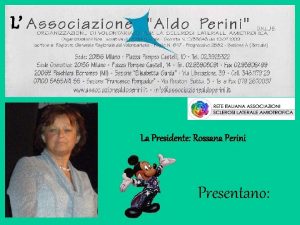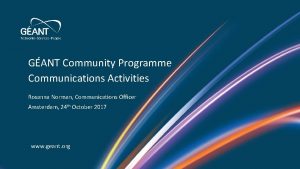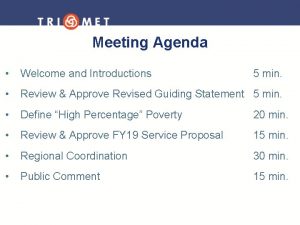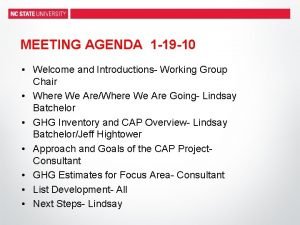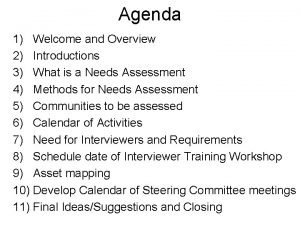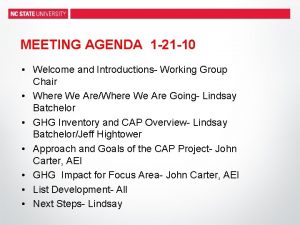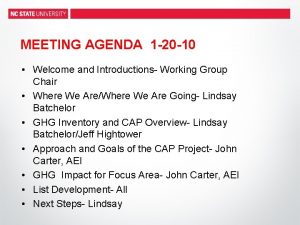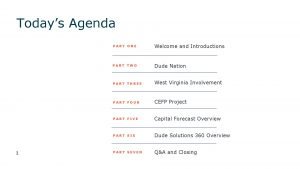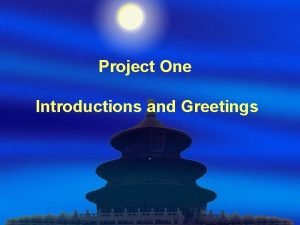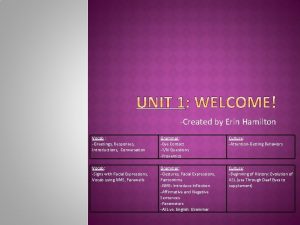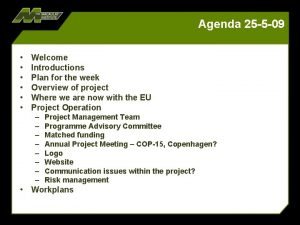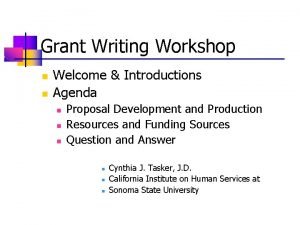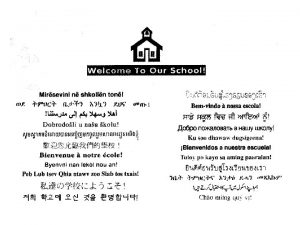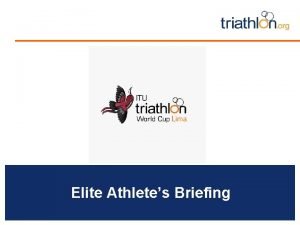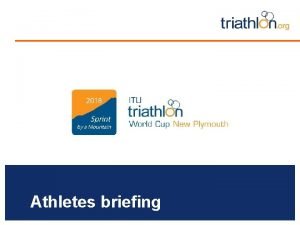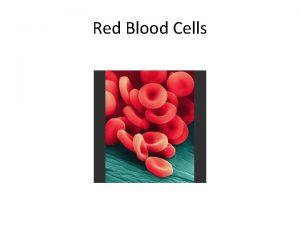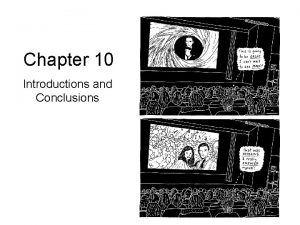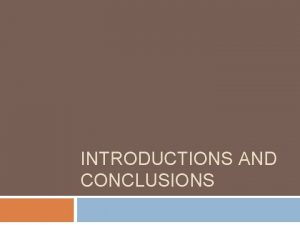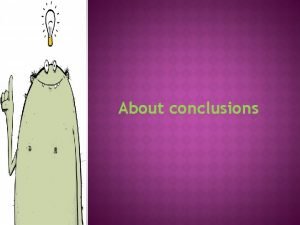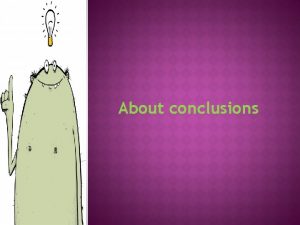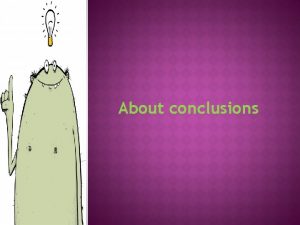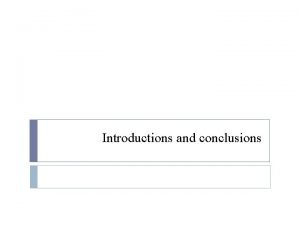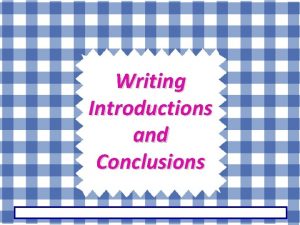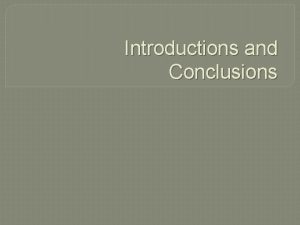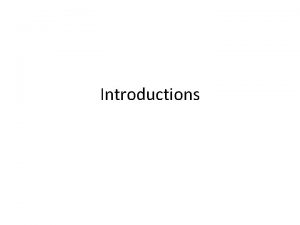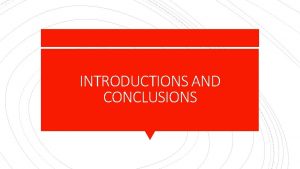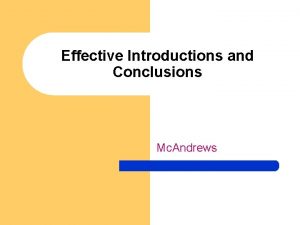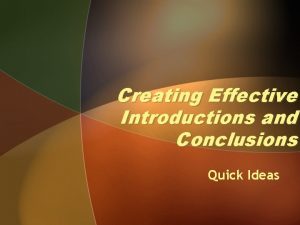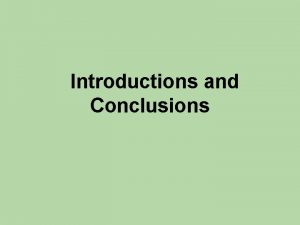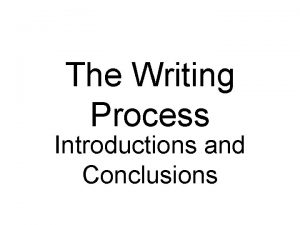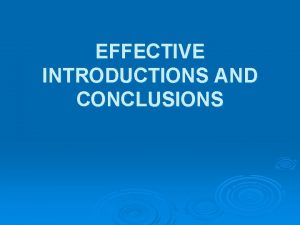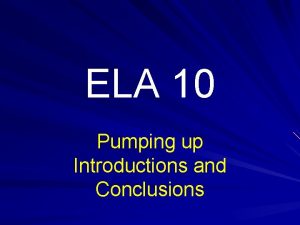Presentation Tips Introductions and Conclusions Adapted from Rosanna



















- Slides: 19

Presentation Tips: Introductions and Conclusions Adapted from Rosanna Islas’ presentation

1. Greet and Welcome the Audience • When you do a presentation, you always want to WELCOME the audience. For example, you may say: Welcome, ladies and gentlemen. Welcome, everyone. I’d like to welcome you today. Let’s get started. (practice saying these to the person next to you wth a big smile on your face—enthusiasm carries to your voice!)

Attention Getters • It is always good to get the audience’s attention. Don’t think you don’t have time for this. You do not want them to be BORED from the beginning!

How do we get the audience’s attention? You can get the audience’s attention in your INTRODUCTION when you: • Give an interesting/fun fact • An interesting story • A problem to think about • A thought-provoking question • A famous quote

Give a interesting fact You can always give a fun fact about the topic you will present using the following format: • Did you know that (according to the website Universe Today)…(71% of the earth is covered in water? ) • I read the other day (in the New York Times) that…(one out of every 3 Americans gets too little sleep) • Research (by the Council on Automotive Safety) has shown that…(being distracted while driving causes more than 30% of car accidents) TURN to your partner, and look up an interesting fact about time capsules. Use the attention getters above to state the fact.

A problem to think about Another way to get the audience’s attention is think about a problem that they would want to solve and give them something to think about. Then explain how you are going to help them solve it. For example: • Everybody wants to be happy. But not everyone knows how to achieve happiness. Suppose if I could explain the 3 ways to achieve lifetime happiness, would you be interested? Take a few minutes to think of what some problems people are trying to solve by creating a time capsule. Using the format above, write down the problem and the questions/solution you would ask your audience. Share with your partner.

Tell a brief story/anecdote Telling a story or an anecdote about an experience you have had, can always be a great way to get the attention of the audience. You can do that by saying: • The other day I was… • You know, when I think about…I’m reminded of …. • Have you ever been in a situation where… Think of a story about a favorite childhood object and describe it in two sentences. Explain what it means to you.

Famous Quotes There are so many famous quotes that can make a person think. When you use the quote, make sure to include who said it and possibly their credentials and then explain WHY this relates to your topic. You can use the following ways: • Phebe Shen, an English teacher, once said and I quote “Hacettepe University students are the best. ” As the best students, they deserve the best university, in fact, a perfect university. • Let me start by quoting Shakespeare, a famous poet, who said, “____________. ” • Lady Gaga, who needs no introduction, once said, “ ’’ Do you have any famous quotes? Share a famous quote you know with your partner.

Practice saying the quote below, with the format you just learned. Then transition into a speech on a topic of your choosing.

Transitioning from the Intro to the Body of Your Presentation • Once you’ve gotten your audience’s attention, now it’s time to focus and get the audience ready for the rest of it. Do this by giving your purpose/focus and possibly an overview • Let me begin by giving an overview of what we’ll discuss today… • OUTLINE Example: First, I am going to explain what the Argentine cuisine consists of. Then, I will give its history and origins. Third, I will point out the health factors, both negative and positive. And finally, I will speak about why it is ranked as one of the best cuisines in the world. • To get started, let’s examine … • Let’s get started talking about … • Now that we’ve given an overview, let’s start with … Now that I’ve given you an overview of what we’ll be discussing today, let’s begin with the characteristics of Argentine cuisine.

Avoid the Following • Apologetic statement: This subject might not interest some of you. • General statement presented in a general way: Time capsules have interested people for a long time. • Story or joke that does not relate or get explained as to how it relates to the speech topic. • Rhetorical question that you don’t really want the audience to consider or answer: Did you ever make a time capsule when you were a kid?

PLAN YOUR INTRODUCTION Plan your introduction but you can do it last. Make sure to include the following: 1. Welcome Phrase. Think of a friendly way to welcome your audience. 2. Attention-getting opening: Think of at least 2 techniques you could use to get your audience’s attention. 3. Introduce the focus/purpose of your presentation. What focus did you take in choosing your objects? Why? If you name some of the key ideas from the presentation, make sure they are in the order you plan to present them in.

CONCLUSION • When you conclude, make sure to bring the audience “full circle. ” • Most people remember what you said first and last most clearly so do not skip this part. • Do not say “That’s all. ” It should be obvious that you have ended.

Transition from Body to Conclusion For a short speech, you might conclude with a single statement: • In short … • In summary … • In conclusion … In a longer presentation, your conclusion might include a review of a the key points: • Let’s summarize the key lessons … • Let’s recap what we’ve covered today … In short, we talked about Argentine cuisine and its history. We also examined the health factors and why it is considered the best cuisine in the world.

Full Circle Ending • Refer back to the introduction of your speech and the attention getter you used. • “As we have seen, more than 33% of people in the US lack the proper sleep to function and stay healthy. This is a serious deficit that cannot be made up. We need to put down the remote control, the i. Phone, the i. Pad, the devices, and go to sleep. ”

Present a Challenge • Ask the audience to apply what you told them today: • “We know that everyone wants to be happy and now you know the three things you need to do in order to be so. It may not be easy, but are you willing to do what it takes? I know I am. ”

Quote Ending • Use a famous quotation that directly focuses on your main point. Or possibly, if you started out with a quote, refocus using the same quote. • “I started out my presentation with a quote by Albert Einstein showing the importance of making mistakes. It’s clear that mistakes should be applauded, not punished. Let’s all keep that in mind when we go and face a room full of students tomorrow. ”

Make an Impression • Don’t speed through your ending • Emphasize what’s important, the take away • End with a downward intonation so it’s clear you’ve ended • When you take your ideas seriously, and with sincerity, so will your audience.

That’s all.
 Perini rosanna
Perini rosanna Rosanna norman
Rosanna norman Rosanna cancellieri gambe
Rosanna cancellieri gambe Agenda welcome and introductions
Agenda welcome and introductions Agenda welcome and introductions
Agenda welcome and introductions German family vocabulary
German family vocabulary Agenda welcome and introductions
Agenda welcome and introductions Meeting agenda welcome and introductions
Meeting agenda welcome and introductions Agenda welcome and introductions
Agenda welcome and introductions Agenda welcome and introductions
Agenda welcome and introductions Greetings and introductions
Greetings and introductions Asl greetings and introductions
Asl greetings and introductions Meeting agenda welcome and introductions
Meeting agenda welcome and introductions Agenda welcome and introductions
Agenda welcome and introductions Agenda welcome and introductions
Agenda welcome and introductions Agenda for parent orientation
Agenda for parent orientation Agenda welcome and introductions
Agenda welcome and introductions Agenda welcome and introductions
Agenda welcome and introductions This passage is adapted from jane austen
This passage is adapted from jane austen Erythroposis
Erythroposis
